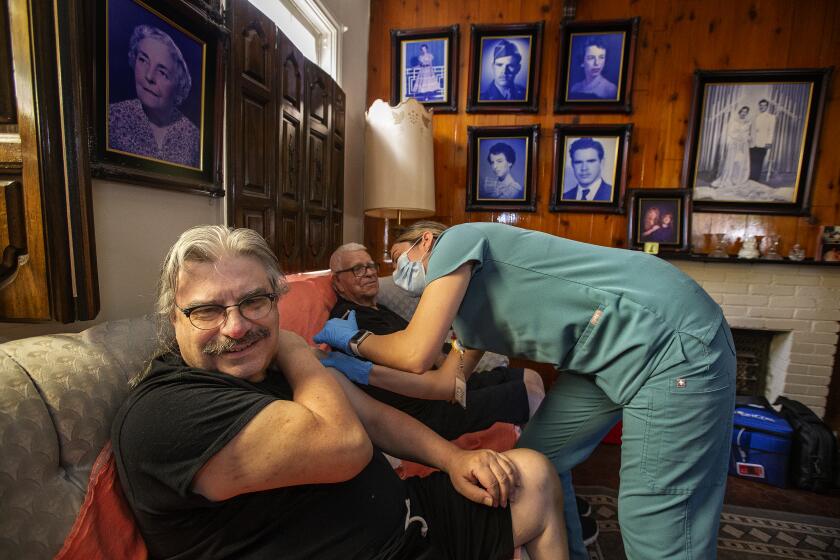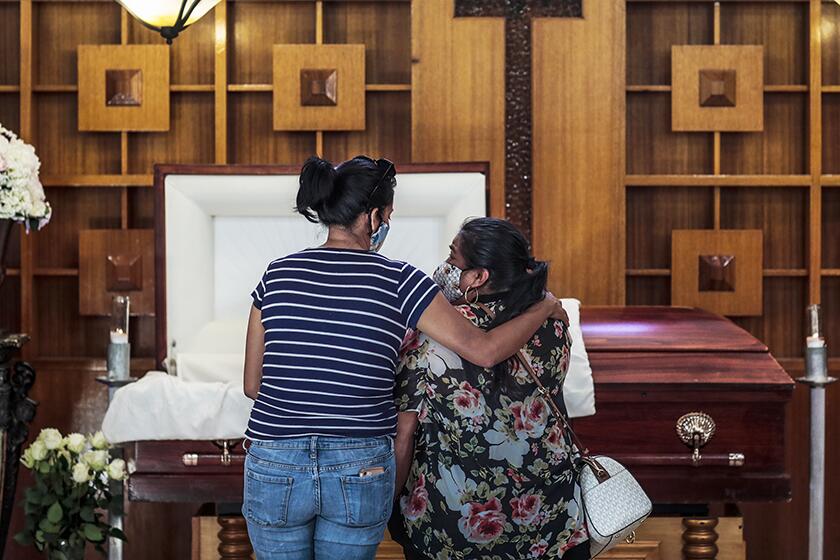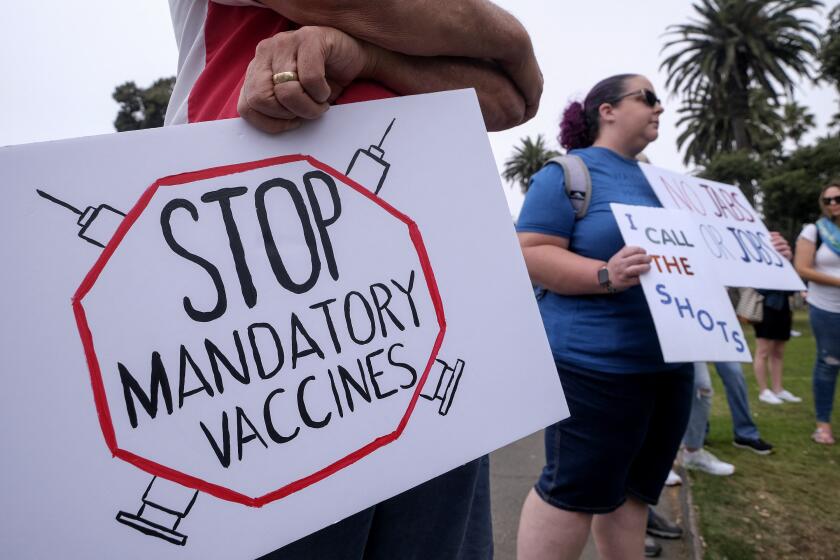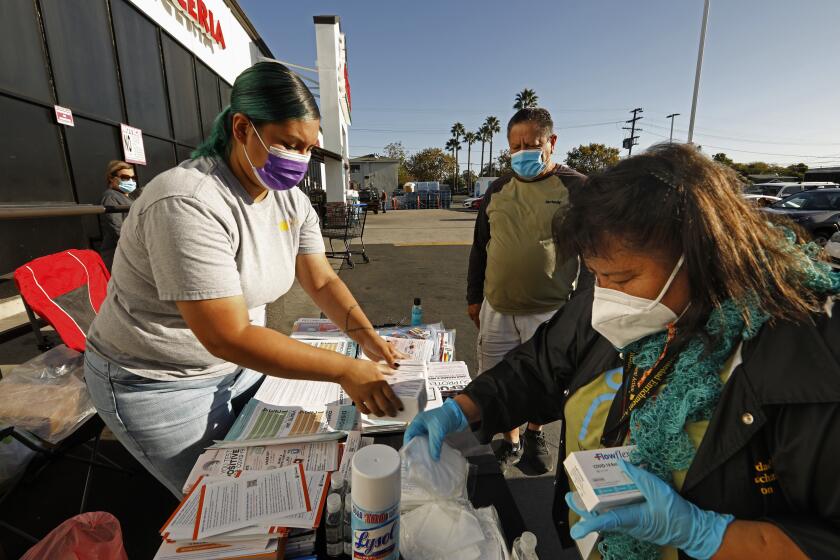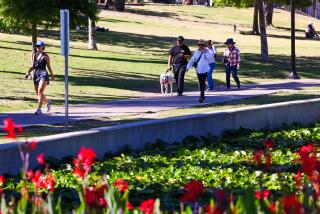L.A. County coronavirus cases, hospitalizations rising as Thanksgiving nears
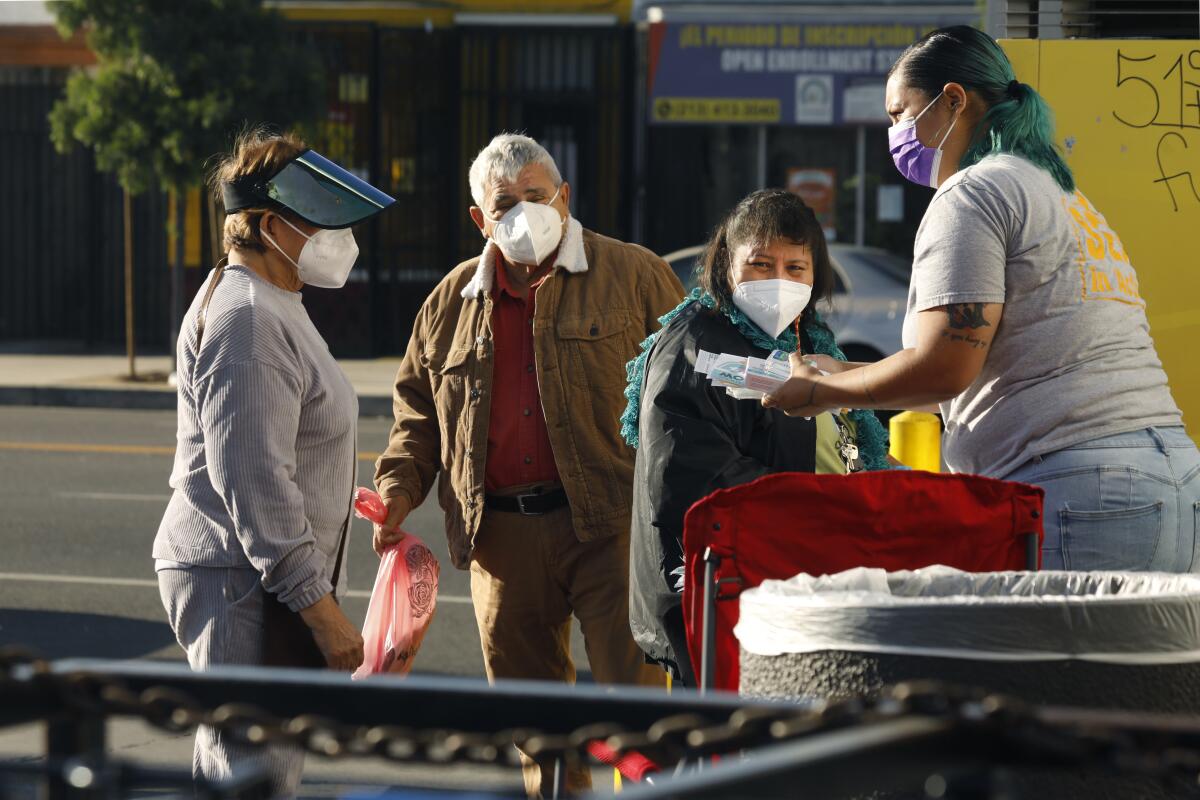
- Share via
Coronavirus cases and hospitalizations are starting to increase in Los Angeles County amid the wider circulation of newer Omicron subvariants.
With flu and respiratory syncytial virus, or RSV, also on the rise statewide, officials are urging residents to take steps to protect themselves — including wearing masks and getting the updated COVID-19 booster and flu shots.
“Our winter virus season is here early, especially for our kids. We are seeing stress on our clinics and hospitals that care for kids, especially infants and kids under 12,” Dr. Tomás Aragón, California’s public health director and health officer, said in a statement. “Kids get infected from other kids and adults, so everyone needs to do their part.”
Besides getting vaccinated or boosted and wearing masks, Aragón urged Californians to stay home when they’re sick, wash their hands regularly and cover up when they cough or sneeze.
So far, though, few residents have gotten the updated COVID-19 vaccine — also known as the bivalent booster — that became available in September. Only 12% of L.A. County residents 5 and older eligible for the updated booster have received it. Statewide, bivalent booster coverage stands at 13.3%.
A confluence of respiratory illnesses has some California officials warning of a possible triple threat that could strain healthcare systems.
The booster campaign is also lagging among seniors, a group at particular risk of severe health impacts from COVID-19. Only about 25% of L.A. County residents 65 and older have gotten the shot.
“This low number is worrying, especially given the possibility of a winter surge fueled by new strains of the virus that are very infectious,” county Public Health Director Barbara Ferrer said. “Those over 65 remain at elevated risk for severe illness from COVID-19. And for many older people, it has been months since their last booster.”
Getting an updated booster is important because immunity from coronavirus infection — whether from previous vaccinations and boosters or a prior illness — weakens over time.
“If a person contracts COVID-19, there is always the risk of hospitalization and death,” Ferrer said. “While three-quarters of the people who pass away are in fact elderly, that means 25% of the people who pass away are not.”
COVID-19 was the second leading cause of death in Los Angeles County in the first six months of 2022, illustrating the outsized impact the pandemic has had on mortality rates.
In L.A. County, just 15% of eligible adults age 50 to 64 have received the updated booster, and only 10% of those in their 30s and 40s have. Only 6% of the eligible youngest adults have gotten an updated booster, as have 5% of adolescents and 4% of children age 5 to 11.
“Even if a person contracts Omicron, and it feels like a mild infection, there is always the risk of passing it onto another person for whom it will not be a mild infection, especially if you’re asymptomatic or if you don’t even have symptoms,” Ferrer said.
Lower uptake of the updated booster among seniors has been noted in Central and South L.A., Southeast Los Angeles County, the Eastside, parts of the northern San Fernando Valley and the Antelope Valley.
Areas with higher rates include the Westside, the South Bay, the Hollywood Hills, the southern San Fernando Valley and the Santa Clarita Valley.
The San Gabriel Valley was split, with some areas like Pasadena, South Pasadena, San Marino, La Crescenta, Altadena, La Cañada Flintridge, Sierra Madre, Claremont and Walnut reporting a high uptake, while cities such as Azusa, Baldwin Park, El Monte, Irwindale and Rosemead had lower adherence.
“Even in areas where the bivalent booster uptake is higher, it’s still not high enough. There’s no areas where it meets that 60% number that we want to see for preparedness,” Ferrer said.
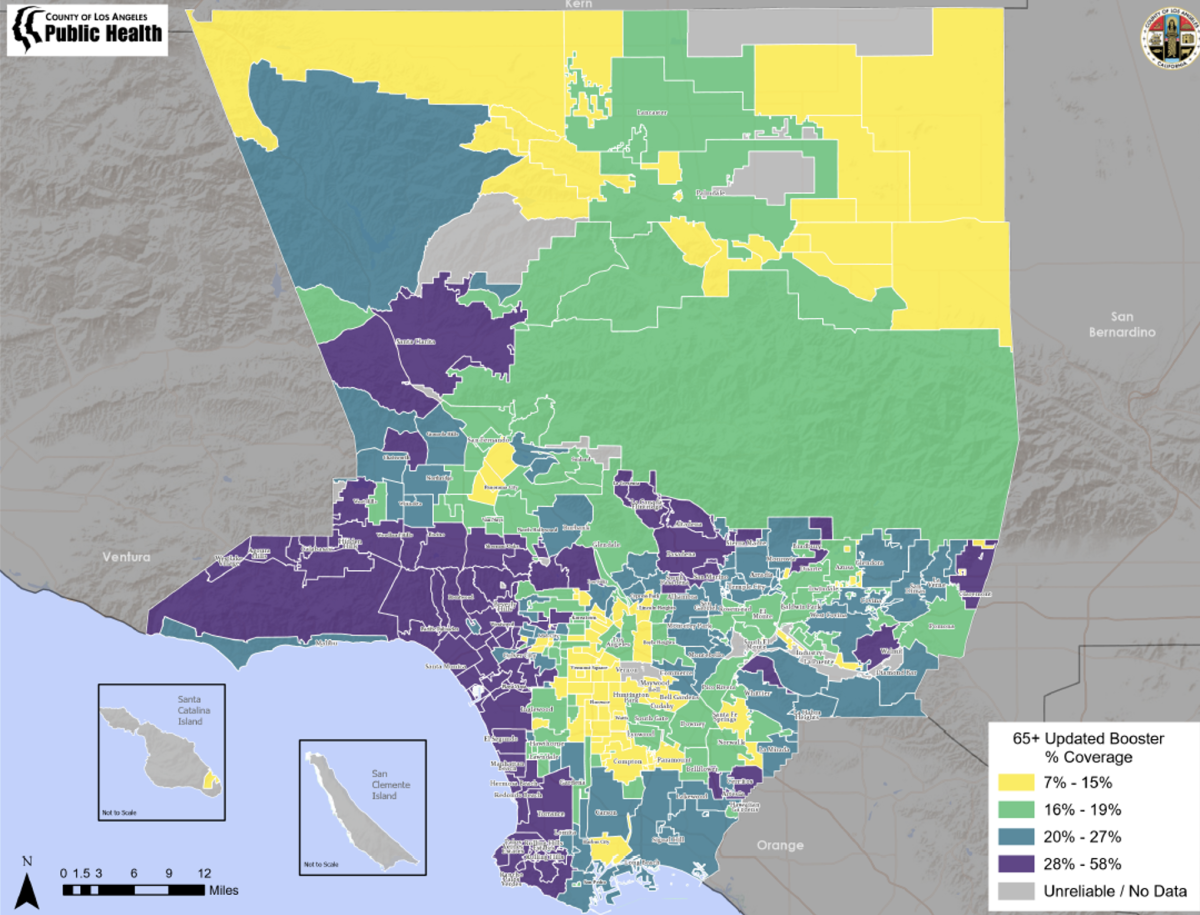
Officials fear that low uptake of the updated booster will result in needless infections, hospitalizations and deaths in the coming months. Ferrer urged that people get their COVID booster and flu shot as soon as possible, since it is now less than two weeks before Thanksgiving — and it takes two weeks for the shots to provide full protection.
“Maximize your protection and get vaccinated today if you’re planning on having as much protection as you can from the vaccines by Thanksgiving,” Ferrer said. Getting vaccinated as soon as possible, she added, “is going to help you add protection.”
There are a few reasons why this latest phase of the COVID-19 vaccine campaign has been slow, officials and experts say. Many people may not know about the additional booster or realize that, unlike earlier offerings, it has been redesigned with a new formula that protects against both the original version of the coronavirus as well as some of the more recent Omicron strains, including BA.5.
Others may think that they’re still well-protected by their prior vaccine or booster. And, for some, they may just be unwilling to roll up their sleeve for a fourth, fifth or even sixth time.
“We weren’t able at the beginning to say this is a vaccine you’re going to need to take over and over and over again,” Ferrer said. “So I feel like there is a lot of confusion, and we haven’t done a good job sorting through those confusions.”
From public health’s perspective, she said, “we’re back to an all-out effort.”
Americans who still aren’t fully vaccinated against COVID-19 probably have some immunity from a past infection. They may not be so dangerous anymore.
Officials have long warned of the possibility that the coronavirus could rebound again this fall and winter. And while the overall pandemic picture remains relatively rosy, there are some signs that transmission is beginning to ramp up.
Statewide, coronavirus cases for the week that ended Tuesday climbed 10% from the prior week, to 59 cases a week for every 100,000 residents. A rate of 50 to 99 is considered substantial; 100 or more is considered high.
The number of coronavirus-positive patients hospitalized statewide climbed 8% from the prior week, to 1,871 as of Thursday.
Los Angeles County was averaging 1,302 coronavirus cases a day for the weekly period that ended Thursday, a 24% increase from the prior week. On a per capita basis, L.A. County was recording 90 cases a week for every 100,000 residents.
“We’ve really been slowly but steadily increasing since Nov. 1,” Ferrer said. Should the case rate rise to 100 or more, L.A. County will again strongly recommend wearing masks in indoor public settings.
There were 502 coronavirus-positive patients in hospitals in L.A. County on Thursday, up 11% from the prior week.
Statewide, estimates suggest the share of admitted coronavirus-positive patients who are in the hospital due to COVID-19 illness has remained relatively stable, at around 45%, since April. The other patients are being treated for issues not related to COVID-19.
“It is important to note that even though half of these patients may not be hospitalized because they have COVID-19, they still influence hospital workload and burden due to special infection control precautions and placement that any patient with COVID-19 infection needs that is different than other patients,” the California Department of Public Health wrote in a statement to The Times.
The rise of the new coronavirus subvariants is raising concerns of a possible COVID-19 resurgence in fall and winter, as past surges were driven by emerging variants.
Officials also are closely watching the rising dominance of new Omicron subvariants. Combined, BQ.1 and BQ.1.1 comprise an estimated 44% of coronavirus cases nationwide, according to the latest figures from the U.S. Centers for Disease Control and Prevention. BA.5, long the dominant version of the virus, now accounts for just under 30%.
“Given the rapid rise of BQ.1 and BQ.1.1, many are predicting these strains — which are highly transmissible — are likely to drive an increase in cases this fall and winter,” Ferrer said.
But “while part of the reason they outcompete other COVID strains that are circulating is because they’re evading some of our prior protections,” Ferrer noted that BQ.1, BQ.1.1 — as well as another subvariant, BF.7 — are all descendants of BA.5.
“This is very likely to indicate that the new bivalent booster is a good match for reducing severe illness and death,” she said.
So far, BQ.1.1 hasn’t resulted in a surge in hospitalizations. Dr. Eric Topol, director of the Scripps Research Translational Institute in La Jolla, wrote Friday on Twitter that New York state — which has the highest percentage of coronavirus cases due to BQ.1.1 — “still shows no sign of increased COVID hospitalizations.”
However, the pandemic continues to exact a deadly toll. At least 1,167 COVID-19 deaths have been reported in California since the start of October, including about 400 in Los Angeles County.
Of particular concern was an increasing number of coronavirus outbreaks at nursing homes in L.A. County. There were 21 in the past week, a level large enough for it to be considered of “high concern” by officials, Ferrer said. Only about 50% of residents in skilled nursing facilities have received the updated booster, and efforts are underway to get more of them the shot.
More to Read
Sign up for Essential California
The most important California stories and recommendations in your inbox every morning.
You may occasionally receive promotional content from the Los Angeles Times.
